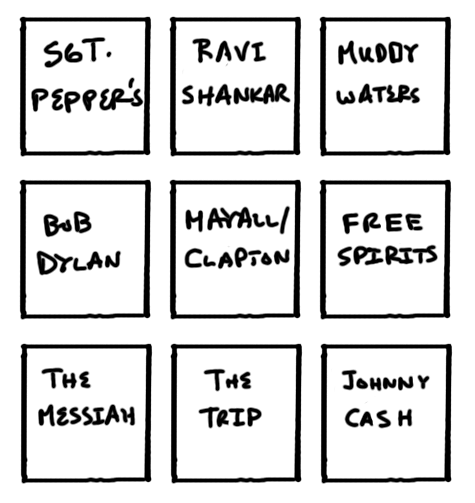
- Saturday, July 12th, 2014
- evolutions and revolutions
-
I spent ten days in the Pacific Northwest recently. The trip included presentations to the CFA societies of Seattle and Portland, as well as some meetings with investment organizations in those cities. But there were also mountains and coastlines and high deserts and big rivers — and family events, cultural experiences, and an old-fashioned Fourth of July celebration with a big parade and fireworks.
For me, as for most people, inspiration usually comes when I have been stretched by a new experience, whether I realize it at the time or not. My trip was a visual and conceptual feast, starting within a few minutes of arriving in Seattle, when I looked at nine LPs arrayed on a wall in an exhibit at EMP Museum:
 In order, they were Sgt. Pepper’s Lonely Hearts Club Band (The Beatles), Sound of the Sitar (Ravi Shankar), The Real Folk Blues (Muddy Waters), John Wesley Harding (Bob Dylan), Blues Breakers (John Mayall, with Eric Clapton), The Free Spirits, The Messiah (by Handel), The Trip (original sound track), and Johnny Cash at Folsom Prison.
In order, they were Sgt. Pepper’s Lonely Hearts Club Band (The Beatles), Sound of the Sitar (Ravi Shankar), The Real Folk Blues (Muddy Waters), John Wesley Harding (Bob Dylan), Blues Breakers (John Mayall, with Eric Clapton), The Free Spirits, The Messiah (by Handel), The Trip (original sound track), and Johnny Cash at Folsom Prison.They were part of an exhibition, “Hear My Train A Comin’: Hendrix Hits London.” The curators had selected the albums from among two hundred owned by Jimi Hendrix at the time of his death.
You immediately see some connections — between The Beatles and Shankar, among the bluesmen, and the inspired pairing of Johnny Cash and Bob Dylan in a studio in 1969. And, yes, John Wesley Harding includes “All Along the Watchtower,” which Hendrix so famously covered. When you find out that The Free Spirits featured Larry Coryell and The Trip was made up of songs from Electric Flag (with Mike Bloomfield), in your head you start to imagine great guitarists in a grand round of call and response.
But, The Messiah?
I often use music in analogies about the investment world. For example, the image above appearing without the words looks a lot like the Morningstar style box. In musical styles as in investment styles, we try to put people in boxes because it’s easier for us to think of categories rather than spectra. Invariably, the categories are marked by artificial divisions and are backward-looking, making it hard to fit a truly unique and insightful approach into the old way of thinking.
The theme of the Hendrix exhibit was how he took London by storm, playing in ways that others had never played before, astonishing even the leading guitarists of the day and forcing them to reconsider their own work in light of his revolutionary style.
A display of his band’s instruments was a reminder that you don’t need complexity to achieve greatness. They consisted of a small drum kit, a bass, a guitar, and three crudely-made effects pedals. All showed signs of significant wear.
Another exhibit at EMP focused on the history of the guitar. The chronology was marked by developments from vastly different parts of the music world — the new sounds reverberated across one genre after another, propagating in unexpected ways. The videos playing in the room emphasized the point — and demonstrated that genius has no borders. (Also in the room: The guitar Clapton used on “Layla,” and the one Hendrix played at Woodstock. Wow.)
The greats integrate and refine and explore and change things in ways that are completely unexpected based upon the categories to which we cling. That’s true in investing as in music, although there is one glaring difference. The recognition of change and of greatness can happen quickly, almost instantaneously, in the music industry. The investment industry, by contrast, moves at a glacial pace, with many aspects of it not changing much for years and decades.
Jimi Hendrix was a revolutionary. The Beatles were revolutionaries too, although their musical greatness came more from their willingness to constantly evolve over time rather than from the cultural tsunami of Beatlemania.
Change happens. It may be evolutionary or it may be revolutionary, but invariably it is driven by those who aren’t bound by conventional norms, who can look past the labels and see greatness wherever it is (The Messiah, anyone?), who can create something that the rest of us couldn’t even imagine.
For individuals and organizations operating in the investment industry, with its benchmarking and herding and style boxes and performance derbies, it is hard to buck the system. But in small ways and large — in bits of evolution and spasms of revolution — there are those who do so.
If only we listened to the new sounds that they create as much as the same old songs that everyone knows.
